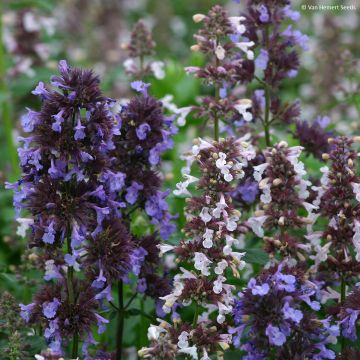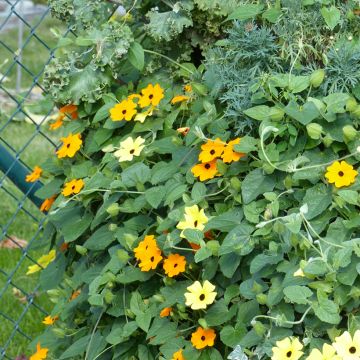

Graines de Thlaspi Candytuft Géant à fleur de jacinthe - Ibéris
Iberis Hyacinth Flowered Seeds
Iberis Géant à fleurs de jacinthe
Garden Candytuft, Globe Candytuft,
Special offer!
Receive a €20 voucher for any order over €90 (excluding delivery costs, credit notes, and plastic-free options)!
1- Add your favorite plants to your cart.
2- Once you have reached €90, confirm your order (you can even choose the delivery date!).
3- As soon as your order is shipped, you will receive an email containing your voucher code, valid for 3 months (90 days).
Your voucher is unique and can only be used once, for any order with a minimum value of €20, excluding delivery costs.
Can be combined with other current offers, non-divisible and non-refundable.
Home or relay delivery (depending on size and destination)
Schedule delivery date,
and select date in basket
This plant carries a 6 months recovery warranty
More information
We guarantee the quality of our plants for a full growing cycle, and will replace at our expense any plant that fails to recover under normal climatic and planting conditions.
Would this plant suit my garden?
Set up your Plantfit profile →
Description
Iberis amara coronaria 'Giant Hyacinth Flowered' is a great improvement of a species of annual candytuft, also known as rocket candytuft. It is sown directly in its final position, after the last frosts, and quickly forms pretty, prostrate, well-branched mounds that are covered from June to September, with large clusters of pleasantly scented, white flowers. Its snowy, fragrant cushions work wonders in rock gardens, borders and planters. Grow in moist to dry, well-drained soil in the sun.
Iberis amara is native to Central and Southern Europe and Algeria. It is present in almost all of France. The common English name, 'candytuft', comes from Candia, the ancient name of Heraklion, a large city in Crete where the plant is also found. This plant of the family Brassicaceae, formerly known as Crucifereae, can be found in fields and on hillsides. It is a low-lying annual to biennial plant that forms small clumps, 30 to 40 cm in width and height. The semi-woody, branched stems are covered with long, thin, slightly lobed and dentate, ciliate, pubescent, spatulate leaves that are dark green in colour. A plant sown at the end of summer will survive the winter in favourable climates, flowering only from spring onwards. Seedlings sown in spring require 10 to 12 weeks to flower. From May to October, depending on the climate, the cushions are covered for 3 months with pure white inflorescences made up of tiny white flowers that are gathered into beautiful, highly fragrant clusters. Its seeds, which contain a bitter substance, have long been used in phytotherapy, particularly in homeopathy to treat gastrointestinal problems.
With its attractive prostrate habit and snowy, fragrant blooms, the 'Giant Hyacinth Flowered' candytuft is fantastic in borders, emphasizing the contour of a pathway or the round edges of a flowerbed. It can also be planted in small drifts, between the stones of a rock garden where it will stay decorative for most of the year. This species adapts well planted on low walls or in their interstices, in the company of Aubrieta, houseleeks, sedums and the Carpathian harebell. This candytuft can be used to decorate basins, window boxes and the bases of drought-tolerant perennials or shrubs. For best results, place it in the sun in any well-drained, preferably limestone soil.
Report an error about the product description
Flowering
Foliage
Plant habit
Botanical data
Iberis
Géant à fleurs de jacinthe
Brassicaceae
Garden Candytuft, Globe Candytuft,
Cultivar or hybrid
Other Flower seeds A to Z
View all →Planting and care
Sow candytuft 'Giant Hyacinth Flowered' seeds from March to May, after the last frosts. Or in late summer in milder climates. Sow directly outdoors or in a seedbed on well-drained and well-prepared soil. Choose a sunny spot. Germination takes about 21 days at a temperature of about 18°C. When the seedlings are sufficiently developed to be handled, thin out and plant out as soon as possible to the desired location. Flowering will occur 10 to 12 weeks after sowing.
Sowing period
Intended location
This item has not been reviewed yet - be the first to leave a review about it.
Similar products
Haven't found what you were looking for?
Hardiness is the lowest winter temperature a plant can endure without suffering serious damage or even dying. However, hardiness is affected by location (a sheltered area, such as a patio), protection (winter cover) and soil type (hardiness is improved by well-drained soil).

Photo Sharing Terms & Conditions
In order to encourage gardeners to interact and share their experiences, Promesse de fleurs offers various media enabling content to be uploaded onto its Site - in particular via the ‘Photo sharing’ module.
The User agrees to refrain from:
- Posting any content that is illegal, prejudicial, insulting, racist, inciteful to hatred, revisionist, contrary to public decency, that infringes on privacy or on the privacy rights of third parties, in particular the publicity rights of persons and goods, intellectual property rights, or the right to privacy.
- Submitting content on behalf of a third party;
- Impersonate the identity of a third party and/or publish any personal information about a third party;
In general, the User undertakes to refrain from any unethical behaviour.
All Content (in particular text, comments, files, images, photos, videos, creative works, etc.), which may be subject to property or intellectual property rights, image or other private rights, shall remain the property of the User, subject to the limited rights granted by the terms of the licence granted by Promesse de fleurs as stated below. Users are at liberty to publish or not to publish such Content on the Site, notably via the ‘Photo Sharing’ facility, and accept that this Content shall be made public and freely accessible, notably on the Internet.
Users further acknowledge, undertake to have ,and guarantee that they hold all necessary rights and permissions to publish such material on the Site, in particular with regard to the legislation in force pertaining to any privacy, property, intellectual property, image, or contractual rights, or rights of any other nature. By publishing such Content on the Site, Users acknowledge accepting full liability as publishers of the Content within the meaning of the law, and grant Promesse de fleurs, free of charge, an inclusive, worldwide licence for the said Content for the entire duration of its publication, including all reproduction, representation, up/downloading, displaying, performing, transmission, and storage rights.
Users also grant permission for their name to be linked to the Content and accept that this link may not always be made available.
By engaging in posting material, Users consent to their Content becoming automatically accessible on the Internet, in particular on other sites and/or blogs and/or web pages of the Promesse de fleurs site, including in particular social pages and the Promesse de fleurs catalogue.
Users may secure the removal of entrusted content free of charge by issuing a simple request via our contact form.
The flowering period indicated on our website applies to countries and regions located in USDA zone 8 (France, the United Kingdom, Ireland, the Netherlands, etc.)
It will vary according to where you live:
- In zones 9 to 10 (Italy, Spain, Greece, etc.), flowering will occur about 2 to 4 weeks earlier.
- In zones 6 to 7 (Germany, Poland, Slovenia, and lower mountainous regions), flowering will be delayed by 2 to 3 weeks.
- In zone 5 (Central Europe, Scandinavia), blooming will be delayed by 3 to 5 weeks.
In temperate climates, pruning of spring-flowering shrubs (forsythia, spireas, etc.) should be done just after flowering.
Pruning of summer-flowering shrubs (Indian Lilac, Perovskia, etc.) can be done in winter or spring.
In cold regions as well as with frost-sensitive plants, avoid pruning too early when severe frosts may still occur.
The planting period indicated on our website applies to countries and regions located in USDA zone 8 (France, United Kingdom, Ireland, Netherlands).
It will vary according to where you live:
- In Mediterranean zones (Marseille, Madrid, Milan, etc.), autumn and winter are the best planting periods.
- In continental zones (Strasbourg, Munich, Vienna, etc.), delay planting by 2 to 3 weeks in spring and bring it forward by 2 to 4 weeks in autumn.
- In mountainous regions (the Alps, Pyrenees, Carpathians, etc.), it is best to plant in late spring (May-June) or late summer (August-September).
The harvesting period indicated on our website applies to countries and regions in USDA zone 8 (France, England, Ireland, the Netherlands).
In colder areas (Scandinavia, Poland, Austria...) fruit and vegetable harvests are likely to be delayed by 3-4 weeks.
In warmer areas (Italy, Spain, Greece, etc.), harvesting will probably take place earlier, depending on weather conditions.
The sowing periods indicated on our website apply to countries and regions within USDA Zone 8 (France, UK, Ireland, Netherlands).
In colder areas (Scandinavia, Poland, Austria...), delay any outdoor sowing by 3-4 weeks, or sow under glass.
In warmer climes (Italy, Spain, Greece, etc.), bring outdoor sowing forward by a few weeks.



















































